The Best Polework Exercises for Horse and Rider
These 8 ridden and in-hand pole work exercises are a great way to improve horse and rider, and are suitable for horses and ponies.

Polework exercises are great for both horse and rider. Aside from building physical strength, pole exercises force your horse to think, which is vital for dressage, show-jumping, and cross country. There are countless pole exercises – ranging from in-hand to ridden – each designed to achieve a slightly different outcome.
How do pole exercises help horses?
Pole exercises are a great way to improve your horse’s fitness and flexibility. They can increase a horse’s range of limb and joint motion, drive engagement of their hindquarters, boost stride length, and improve balance.
By carrying out the right pole work exercises with your horse, you can improve each gait (including canter) – perfect for disciplines such as dressage, and increase strength.
What are the different types of pole work exercises?
There are two ways to perform pole exercises: in-hand and ridden. Each has exclusive benefits.
In-hand exercise gives your horses’ back a rest and allows them to build muscle where the saddle would normally sit. Furthermore, it’s a great way of being able to review your horse from a distance – allowing you to see any weaknesses, e.g. dragging their left toe when going over poles. The specific outcome for your horse will vary depending on the exercise, but can include toning and strength building.
Unlike in-hand exercises, ridden pole work helps both horse and rider. As a rider it can increase your accuracy and straightness, whilst requiring you and your horse to focus – a physical and mental workout. Ridden exercises come with many benefits for your horse, including increased strength building over in-hand exercises (owing to rider weight). If you’d prefer to stick with in-hand exercises, consider our post on Three Exercises To Improve Rider Mobility to build up your own strength.
Simple ridden pole work exercises
You should perform all 5 exercises on both reins to avoid injury through uneven muscle build-up.
Pole Exercise 1: Zig-zag
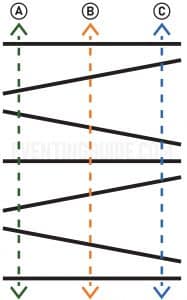
Begin by setting up a zig-zag pattern using seven poles, as outlined in the diagram. When appropriate, this setup can be progressed into raised poles – increasing difficulty for both horse and rider.
Variation in the distance between trotting poles depending on your horizontal position means there are a variety of ways this setup can be ridden (A, B, and C on the diagram). Each keeps the horse engaged and focused on where they need to place their feet, whilst building core strength.
Pole Exercise 2: Crop
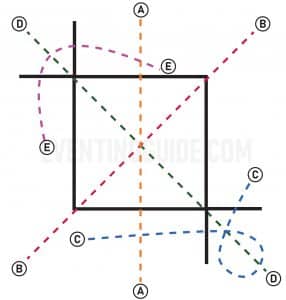
Construct a square out of four trotting poles, and then add two additional poles to either end to create a configuration that looks like a generic crop icon. This setup can be used in a variety of ways, as outlined below.
Using the crop configuration is a great way to practice upward and downward transitions by riding through the square. Straightness can also be developed throughout.
Pole Exercise 3: Chevrons
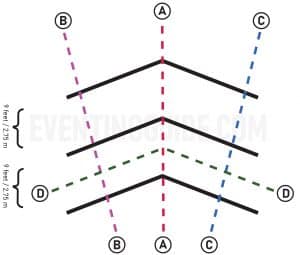
Using six poles create a series of three chevrons, leaving 2.75m between each chevron. This quick and simple layout can be ridden in walk, trot, or canter. It can also be progressed by raising poles at varying distances to encourage the shortening and lengthening of your horse’s strides.
Try riding along line A in walk, trot, and then canter; B in trot; C in canter; and D with halt, rein back, and downward transitions. These exercises can increase all paces, and also obedience by forcing them to be sharper off the leg.
Effective in-hand pole work exercises
The following exercises should be carried out at a walking pace, as it removes all moments of suspension, and therefore movement is performed purely through muscular effort. This makes it the most effective pace for in-hand pole work exercise as it aids strength and muscle development.
Why not try something different with your horse to keep their training varied? You can carry out the above exercises under saddle, in-hand, on the lunge, or in long-reined.
Pole Exercise 4: The Fan
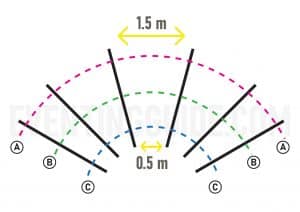
Using six poles set out a fan shape. Place each pole 0.5m (~1 ft) apart at the narrow end of the fan, and 1.5m (~6 ft) at the other end.
This exercise should be undertaken in an active walk, with a slight inside bend in your horse’s body. Depending on the line you choose to take through the poles, you can opt to shorten or lengthen your horse’s stride. This exercise can be advanced by raising every other pole (either entirely or at one end only).
Pole Exercise 5: A line of raised poles
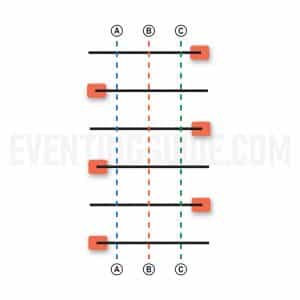
A simple set of poles is a great way to engage your horse’s core, and help improve straightness. Place several poles 1.5m (4 ft) apart, optionally raising alternate ends of each pole.
Your horse mustn’t be rushed through this exercise. Instead, they should be allowed to walk at their natural walking pace. If carried out properly this exercise will help to engage your horse’s core and build strength (primarily through the lifting of their legs).
Pole Exercise 6: Spiral In
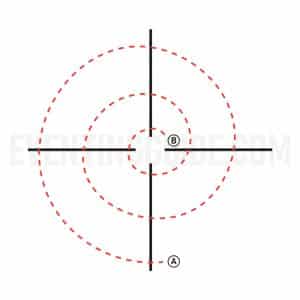
Using 4 (or 8) poles laid out as a cross spiral your horse outwards from the centre. This exercise engages the hind legs as they pass over each pole, improving flexibility in the horse’s back and neck by utilising the appropriate muscles.
Pole Exercise 7: Weaving Line
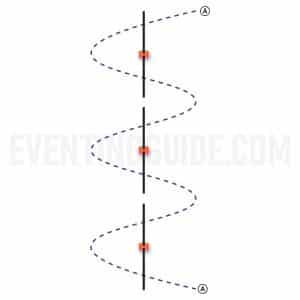
Place two poles end-to-end, then place a block where they meet to raise them off the ground. Repeat this twice so that you are using a total of four poles.
Weave your horse across each pole, varying the extent of each bend to meet your requirements. This exercise improves flexibility throughout the body and encourages the hock to lift up, across the body – a good method of strengthening the sacroiliac joint.
Pole Exercise 8: The Wiggle
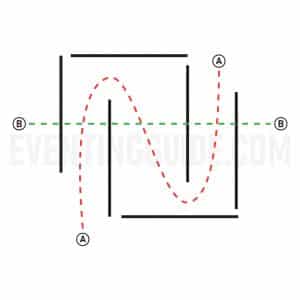
Lay out 6 poles in the style outlined below, and pass your horse through and then around the poles alternately. This exercise is great for improving suppleness, as the poles guide the horse to bend around itself – improving the range of motion throughout the body.
Where can I buy trotting poles?
Trotting poles are available from tack shops and agricultural retailers. They’re also for sale on Amazon, where they can be found in a variety of colours.
In Great Britain, a popular source of trotting poles is Jump 4 Joy. Jump 4 Joy offer poles ranging from 1.8m to 3.5m in length, as well as a choice between round and octagonal cross-sections. Many riders find octagonal poles to be the best choice for use on sloping ground, as it minimises rolling.
It is also common to make trotting poles yourself. A round wooden pole – available from builders’ merchants across the world – and a selection of bright coloured paint is all that’s required. Although “professional” plastic poles are lighter (ideal for manoeuvring), they offer few other advantages.
Frequently asked questions (FAQs)
What does pole work do for horses?
Pole work increases a horses’ core strength, engages their hindquarters, and can improve straightness in both horse and rider. Furthermore, by utilising differences in the distance between trotting poles strides can be lengthened or shortened.
How many strides should a horse have between poles?
Incorrect spacing between poles can result in difficulty. The number of strides between trotting poles varies for horses and ponies, with horses needing an average of 1.4 meters between poles, and ponies requiring 0.9 to 1.2 meters. However, owing to differences in size and stride from horse to horse, you will need to make adjustments to suit your horse.
How do you teach a horse to go over poles?
Teaching a horse to go over trotting poles is easy, however, you shouldn’t rush the process – particularly for young or green horses. Start with a single pole, and slowly build up to multiple poles. Gait is also important; familiarise your horse with pole work in walk before asking for trot or canter.
What do canter poles help with?
Placing canter poles before a fence can help to enforce rhythm, which is particularly useful for horses that rush to fences.
What are your favourite pole exercises? Have you noticed a difference in your horse as a result of utilising pole exercises? Leave a comment below – we’d love to hear from you.
If you’re looking for something new, consider our Effective Gridwork Exercises to Increase Power and Lift post.
4 Replies to “The Best Polework Exercises for Horse and Rider”